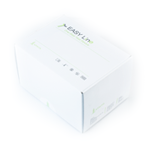| Line | Method & Sample | Product | Package Info |
|---|---|---|---|
| MOLgen | Clinical Specimens | MOLgen DNA HSV-1 / HSV-2 S1 Kit | Tests per Package: 96 |
| Herpes Viruses & ToRCH | “MOLgen DNA HSV-1 / HSV-2 S1 Kit” is an Assay Kit for differential determination of Herpes Simplex Virus Types 1 and 2 DNA by Real-Time PCR method | Code: ME121950 | Package Format: STR |

For Quantity Orders: Request a Quote
Please pay attention to the revision of the document that must be the same as the revision reported in the box label.
In case of discrepancy please contact our Customer Care e-mail: info@adaltis.net.
* Other document related to the product available at Documentation Centre and it is accessible for Adaltis distributors/partners after registration only.
“MOLgen DNA HSV-1 / HSV-2 S1 Kit” is an Assay Kit for differential determination of Herpes Simplex Virus Types 1 and 2 DNA by Real-Time PCR method.
“MOLgen DNA HSV-1 / HSV-2 S1 Kit”is designed for differential determination of herpes simplex virus types 1 and 2 DNA isolated from clinical specimens using extraction kit: “MOLgen Universal Extraction Kit”. Assay is based on real-time polymerase chain reaction (PCR) method with fluorescent detection of amplified product.
The kit contains reagents requiredfor 96 tests, including control samples.
The kit is designed for use with iQ5 iCycler (Bio-Rad, USA), CFX96 (Bio-Rad, USA) and DT-96 (DNA-Technology Research and Production Company, Russia).
“MOLgen DNA HSV-1 / HSV-2 S1 Kit” is designed for the analysis of clinical materials (scrapings of the epithelial cells, saliva, semen, prostatic fluid, urine, serum, plasma, leukocytic mass, whole blood).
Real-time PCR is based on the detection of fluorescence, produced by a reporter molecule, which increases as the reaction proceeds. Reporter molecule is dual-labeled DNA-probe, which specifically binds to the target region of pathogen DNA. Fluorescent signal increases due to the fluorescent dye and quencher separating by Taq DNA-polymerase exonuclease activity during amplification. PCR process consists of repeated cycles: temperature denaturation of DNA, primer annealing and complementary chain synthesis.
Threshold cycle value - Ct – is the cycle number at which the fluorescence generated within a reaction crosses the fluorescence threshold, a fluorescent signal rises significantly above the background fluorescence. Increased fluorescence signal is due to the use of a specific for given DNA sequence DNA hybridization probe that in the course of reaction binds with one of the DNA strands, also providing additional specificity of the method. DNA probe comprises of a fluorescent dye at the 5’ end and of fluorescence quencher at the 3’ end which significantly reduces the fluorescence intensity. During the polymerase synthesis of the complementary strand, due to the 5’-3’ nuclease activity of Taq DNA polymerase the probe is cleaved from the 5’-terminus and separation of the quencher and the dye occurs, resulting in the increase the fluorescence signal due to accumulation of the reaction product. Fluorescence intensity detected depends on initial quantity of pathogen DNA template in the sample.
The use of Internal Control (IC) prevents generation of false negative results associated with possible loss of DNA template during specimen preparation. IC indicates if PCR inhibitors occur in the reaction mixture. IC template should be added in each single sample (including control samples) prior to DNA extraction procedure. The amplification and detection of IC does not influence the sensitivity or specificity of the target DNA PCR.
|
Reagent |
Content |
|
Universal Positive Control Sample (PC) (based on the plasmid DNA with integrated fragments of HSV-1 and HSV-2 DNA) |
1 vial, 1.0 mL |
|
Ready Master Mix (RMM) (lyophilized) |
96 tubes (tests) |
|
PCR optical-quality film |
1.5 sheet |
|
Number of tests |
96 |
|
Code |
ME121950 |
Need assistance to make an order? Contact Sales & Orders Centre order@adaltis.net.
For Application Support application@adaltis.net